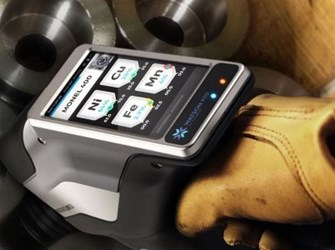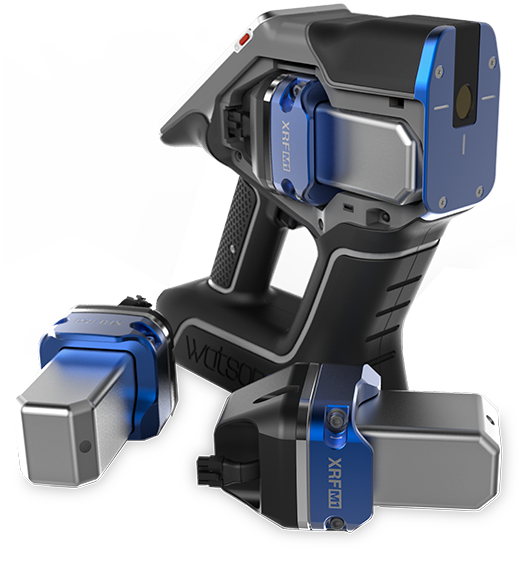X-Ray Technology In The Palm Of Your Hand
By Ed Biller

In August, Tribogenics began nationwide shipping of its Watson XRF, a handheld tool that identifies materials by means of X-ray fluorescence. The device works by using triboluminescence — the generation of a charge imbalance through friction — to create high voltage in a small package.
Tribogenics was on hand at SPIE Optics + Photonics last month, as well; Dr. Carlos Camara, one of the technology’s co-creators, and a colleague presented papers at one of the technical meetings, discussing advances in current and new X-ray source technology.
While the technology’s current capabilities include applications in manufacturing, recycling, and oil and gas production, its designers envision lead detection, precious jewel identification, security, and portable medical imaging among its future applications.
Pistol-Grip Power
In a recent interview with Photonics Online, Camara — also co-founder and chief scientist at Tribogenics — compared the Watson XRF to a cordless power tool: It is powered by a 24V lithium ion battery, which the user simply charges at the end of the work day. Since users need different characteristic X-ray emissions for different applications, the instrument also features user-exchangeable X-ray sources, which swap in and out like a power tool battery.
“We spent a lot of time and energy developing a user experience that is what you would expect, with a nice touchscreen and very intuitive software — it’s very simple to use,” said Camara.
“You don’t need any education. You don’t need any permits. It’s a very safe instrument. It’s a lot safer than a power drill. Obviously, you don’t want to point it at your head and pull the trigger — again, the same thing as using a power drill.”
Replacing each spent x-ray source cartridge is simple, too — just stuff it in an envelope and return it to the manufacturer to have a fresh cartridge sent. Additionally, Camara noted, the device can (conceptually) support a higher energy source, allowing you to use the same instrument to, for example, perform a lead inspection at a much higher accuracy than is currently possible.

Tribogenics’ technology also has the potential to substantially improve resolution for radiography, spectroscopy, and CT imaging, while cutting the costs of those procedures.
“The challenge is that every single application requires a certain amount of development. Determining whether someone has a life-threatening medical condition, using an X-ray picture, that’s generally a harder task than X-ray fluorescence [in an industrial application]. We are walking before running,” said Camara.
Currently, Tribogenics is working with Los Alamos National Lab to develop a portable imaging solution, something that’s going to weigh about ten pounds. But, for now, that initiative is not a front-burner project.
“This is more speculative, but one of the exciting opportunities for us is that we can miniaturize the x-ray source to the point where you can envision building an array of small x-ray sources. Think of LEDs. Lighting solutions with LEDs are, in many cases, based on having many LEDs all shining together, as opposed to one big light bulb,” said Camara.
“That is very exciting in terms of an x-ray source, because all of a sudden you have an array of independently addressable x-ray sources that you can turn on and off as needed, in whatever pattern you might like. That is an increased capability for X-ray imaging. It’s really hard to do that with the technology that is available today.”
Still, Camara said he is most excited about the prospect of making the technology more accessible to more patients.
“As one of the inventors of this new technology, the potential to impact billions of people who don’t currently have access to any x-ray diagnostic, not even for a dental procedure, is part of my motivation.”
However, applications for Watson XRF and other triboluminescence-based technology can only grow as fast as Tribogenics can develop them.
“With different applications, you require different software, so that the device is optimized for that specific thing. There are also other variations, such as changing the properties of the X-Ray detector in the instrument,” said Camara. “As we optimize the systems for those different applications, we will offer an increasing number of solutions, different releases of software, different releases of X-ray sources that you simply replace, et cetera.”
Development Was Simple… In Theory
In 2007, Camara was completing his PhD at the University of California, Los Angeles (UCLA), when he and a team of scientists discovered triboluminescence’s potential as a tool. But triboluminescence has been a known phenomenon since the ancient Greeks; why hadn’t someone else thought of this?
“I think the effect was thought of more as a nuisance. There’s a whole industry whose sole focus is to eliminate the charging of surfaces, because it fries circuit boards and it causes fires,” Camara said.
“Our technology is a close cousin to the Van de Graff generator. Those devices are based on a very similar effect, where you bring the surfaces together and they charge up, and then you carry that charge to a different location. What we did is try to determine the maximum amount of charge you could extract from the surfaces at the nano scale, and we realized that it was a lot more than had previously been appreciated.”
While Camara maintains the technology is “deceivingly simple,” development challenges arose from handling and manipulating the materials themselves.
“Our devices have required us to bring surfaces into contact and then separate them, so it converts mechanical motion into high voltage. That’s the essence of our technology. But that task requires a very precise machine to accomplish. This was one of the challenges, to actually execute such a device in production,” he said.
One challenge with which Camara and his team did not have to contend was radioisotopes, traditionally used in x-ray fluorescence to detect lead in walls or toys, for example.
“Radioisotopes are an alternative way of getting high voltage from a small volume. But, you can imagine all the challenges with radioisotopes. To name a few, you can’t turn them off and they are a security risk — you have to control them much more, since it’s a big risk for them to end up in the wrong hands,” said Camara. “One of our big advantages is that we can generate a high voltage X-ray source from a very small volume, and you can turn it on and off.”
This aspect of the technology could have huge implications in healthcare, as well. According to the World Nuclear Association, between 40 and 45 million medical procedures worldwide are performed annually using radioisotopes. About 90 percent of those procedures involve medical imaging.
Funding, Partnerships, And Getting Off The Ground
From the U.S. Defense Advanced Research Projects Agency (DARPA), the U.S. Army Telemedicine & Advanced Technology Research Center , and other investors, a multitude of government and private parties have taken an interest in Los Angeles-based Tribogenics.
According to Stewart Chalmers, head of marketing for Tribogenics, “our biggest problem right now is meeting the demand (for Watson XRF).”
At $9,999.00, the Watson XRF is the first handheld analyzer ever available for less than $10,000 — about half the cost of competing models, according to company literature. Furthermore, its source cartridge can be replaced for $299.
“It’s an exciting time for this company, and it’s an exciting time for the technology, because we have that full circle: Invention, technology transfer, forming the company, developing the technology, and launching the first product,” said Camara.
For more information, visit http://tribogenics.com/products/ or call the company at 855-972 9123 (855 XRAY 123).
